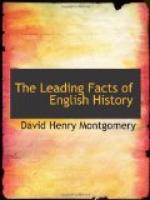With the introduction of Christianity the Latin alphabet, from which our modern English alphabet is derived, took the place of the runic characters, which bore some resemblance to Greek, and English literature began with the coming of the monks.
99. The First Books.
One of the first English books of great value was the “Anglo-Saxon Chronicle,” a history covering a period beginning 1 A.D. and ending in 1154. The work was probably written by the monks in Canterbury, Peterborough, and other monasteries. It may be considered as an annual register of iportant events. Thorpe says of it, “No other nation can produce any history written in its own vernacular, at all approaching the “Anglo-Saxon Chronicle” either in antiquity, truthfulness, or extent, the historical books of the Bible alone excepted.”
Though written in prose, it countains various fragments of poetry, of which the following (rendered into modern English), on the death of Edward the Confessor (1066), may be quoted as an example:
“Then suddenly came On Harold’s
self,
Death the bitter A noble
Earl!
And that dear prince seized.
Who in all times
Angels bore Faithfully
hearkened
His steadfast soul Unto
his lord
Into heaven’s light.
In word and deed,
But the wise King Nor ever
failed
Bestowed his realm In aught
the King
On one grown great, Had needed
of him!”
Other early books were Caedmon’s poem of the Creation, also in English, and Bede’s “Church History” of Britain, written in Latin, a work giving a full and most interesting account of the coming of Augustine and his first preaching in Kent. All of these books were written by the monks in different monasteries.
100. Art.
The English were skillful workers in metal, especially in gold and silver, and also in the illumination of manuscripts.[1] Alfred’s Jewel, a fine specimen of the blue-enameled gold of the ninth century, is preseved in the Ashmolean Museum, Oxford. It bears the inscription: “Alfred me heht gewurcan,” Alfred caused me to be worked [or made].
[1] These illuminations get their name from the gold, silver, and bright colors used in the pictures, borders, and decorated letters with which the monks ornamented these books. For beautiful specimens of he work, see Silvestre’s “Pale’ographie.”
The women of that period excelled in weaving fine linen and woolen cloth and in embroidering tapestry.
101. Architecture.
In architecture no advance took place until very late. The small ancient church at Bradford-on-Avon in the south of England belongs to the Saxon period. The Saxon stonework exhibited in a few buildings like the church tower of Earl’s Barton, Northamptonshire, is an attempt to imitate timber with stone, and has been called “stone carpentry."[2] Edward the Confessor’s work in Westminster Abbey was not Saxon, but Norman, he having obtained his plans, and probably his builders, from Normandy.




